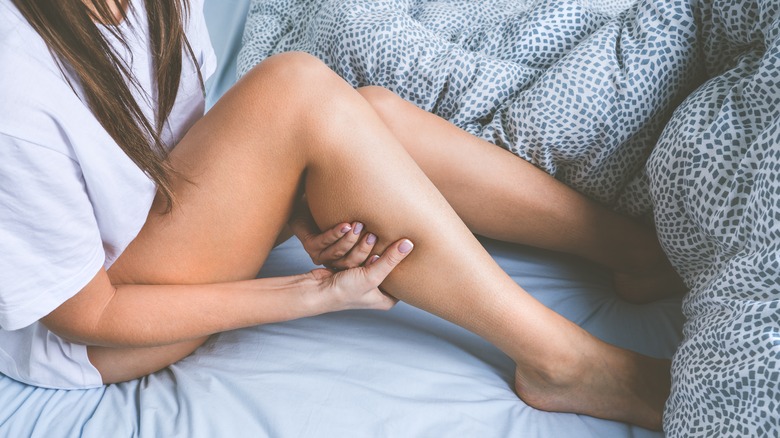Is It Normal To Get Leg Cramps When Following The Keto Diet?
The ketogenic diet has become a popular diet plan to lose weight; you may even be participating yourself. Essentially, the keto diet is a nutrition lifestyle that focuses on severely cutting back on carbs while consuming a significant amount of fats and a decent amount of protein, according to Healthline. It's called the ketogenic diet because eating very little carbs puts your body into ketosis, a metabolic state that forces your body to burn fat for energy.
Some research has shown it to help with weight loss and even help with diabetes, according to a 2018 study from the Expert Review of Endocrinology & Metabolism. However, while many people attribute the keto diet to helping them live a healthier lifestyle, it also comes with a few side effects. Starting the keto diet can have immediate changes, like insomnia, fatigue, nausea, and headaches, among others, although these usually go away within a few weeks, explains Medical News Today. However, one side effect that is common with the keto diet is leg cramps.
Low electrolytes and fluids cause cramps
Experiencing a sudden cramp can be painful and may even be a little scary. Muscle cramps come on quickly and are uncontrollable contractions of one or more of your muscles. They are usually harmless — even though they may not feel that way — although they may lead to temporary immobility until your muscle stops contracting depending on where the cramp occurs, explains Mayo Clinic.
Leg cramps are no different from other muscle cramps and generally occur in the calf muscles, although they can occur in other places as well, according to Healthline. While leg cramps can be caused by a few things, they most commonly are caused by low electrolytes and dehydration. When you start the keto diet, your blood sugar and insulin will most likely drop due to the restriction of carbs which, in turn, will cause you to urinate more and lose more electrolytes. On top of that, as you urinate, you are depleting your body of fluids which can lead to dehydration (via Healthline).
Prevent leg cramps by watching your diet
Now that you know what causes a leg cramp, preventing one is a simple process. Unfortunately, if you do end up getting a leg cramp, there isn't much to be done besides stretching the muscle, applying heat, and waiting for it to be over, according to Mayo Clinic. Runners and other athletes say that swallowing salt or quickly getting electrolytes can relieve a muscle cramp, but the cramp may already be over by the time that happens.
Instead of dealing with leg cramps as they arrive, prevent them beforehand. The best thing to do is to stay properly hydrated which not only will prevent headaches, but also help with other side effects of the keto diet, such as headaches and constipation, explains Healthline. Also, consume enough salt. There are surprising health benefits to eating salt. Add extra salt to your food or simply start having a bowl of chicken broth every day which contains almost 600 milligrams of sodium, according to Aaptive. If that still sounds like too much salt, you can start with bone broth which only has just under 100 milligrams.



